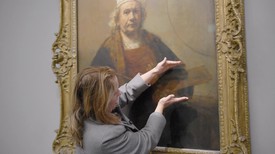About
Every act of creation is first of all an act of destruction.
—Pablo Picasso
Painter, draftsman, sculptor, printmaker, photographer, ceramicist, designer, playwright, and poet, Pablo Ruiz Picasso (1881–1973) contributed peerless innovations to the visual culture of the twentieth century. He created several of the great masterpieces of modernism, including Les Demoiselles d’Avignon (1907) and Guernica (1937), co-invented collage and Cubism, designed groundbreaking sets and costumes for the theater, coined the term “sur-realism,” and invented assembled sculpture (assemblage). Driven by boundless artistic energies and ambitions, he was the very personification of the avant-garde, and many of the movements of the last century could not help but develop in his orbit as artists worked consciously either to absorb his influence or rebel in his shadow.
Born in Málaga, Spain, on the Mediterranean coast, Picasso began painting and drawing under the tutelage of his father, José Ruiz Blasco, himself a painter and an art school instructor. Picasso proved to be a child prodigy, achieving a remarkable academic facility at a young age, and studied formally at art schools in La Coruña, Barcelona, and Madrid. He began to visit Paris in 1901, settling there permanently in 1904. Picasso was influenced by the Modernisme movement in Barcelona and by Post-Impressionism and the Fauves in Paris, yet developed variations distinctly his own.
Early in his career Picasso’s styles and subjects developed in tandem: the poverty in which he and his friends lived manifested in the Blue Period (1901–04); circus performers, harlequins, and the blush of love informed the Rose Period (1904–06). But for the remainder of his career, his essential subjects were perception itself, the mysteries of representation, and his own ability to create. A respect for indigenous African and Polynesian sculpture began to shape the way he depicted volume and mass in the proto-Cubist period that led to Les Demoiselles d’Avignon. With Georges Braque, he incorporated the lessons of Paul Cézanne’s facture and perspective, jump-cut shifts in time from the cinema, and the uncanny improvisations of collage and assemblage to forge the most radical approach to depicting spatial relationships since the Renaissance: Analytic Cubism (1909–12) and Synthetic Cubism (1912–19). These experiments would form the foundation of an idiosyncratic idiom that would permeate his work across all mediums and changes in style for the next fifty years.
The 1920s saw further developments in Cubism; a reflection of his Mediterranean heritage in a muscular neoclassical style; fine, Ingre-esque portraits inspired by photography; and Surrealist, sexy, biomorphic mutations influenced as much by Ovid’s Metamorphoses as by Sigmund Freud. Though his work always remained recognizably his own, Picasso could switch tracks and move between styles in a way that might suggest the work of several painters rather than a singular polymath.
Picasso dedicated much of his effort in the early 1930s to sculpture and printmaking and curated his first career retrospective, an exhibition of 236 works presented at the Galerie Georges Petit, Paris, and the Kunsthalle Zürich in 1932. In 1935 he stopped painting and sculpting for nearly a year to dedicate his time to writing poetry. As the Spanish Civil War intensified, the Republican government named him director of the Museo del Prado in Madrid (albeit in absentia) and commissioned him to create a mural for the Spanish Pavilion of the Paris International Exposition of 1937. He took as his subject the recent destruction of the Basque town of Guernica by Nazi and Italian forces at the behest of the rival Spanish Nationalists, creating one of the most enduring antiwar icons in history. Though Guernica made him a political target of the Fascist regimes, he remained in Paris for the duration of World War II, surviving the Nazi occupation.
After the war Picasso moved to the south of France, where he would reside for the rest of his life. Classical, Mediterranean themes returned to his work. He was offered a municipal museum in Antibes to use as his studio and gifted the works created there to the town, inaugurating the first museum dedicated to his work (Musée Picasso, Antibes). He engaged with the ancient pottery traditions of the town of Vallauris to create ceramics and revived his sculptural practice, making assemblages from roadside refuse and innovative silhouettes of folded sheet-metal. He also created paintings, drawings, and prints, often in series, challenging the history of painting by confronting his heroes, the great masters of the past: Diego Velázquez, Rembrandt van Rijn, Francisco Goya, Eugène Delacroix, Édouard Manet, and Edgar Degas. By appropriating their compositions, improvising on their themes, and sometimes even incorporating these masters as characters in his own invented narratives, Picasso secured his place among them.
Picasso was widely exhibited during his lifetime and continues to be so posthumously. He died in Mougins, France, in 1973, leaving no will. He was married twice: first to Olga Khokhlova in 1917, and then to Jacqueline Roque in 1961. In addition, he had partners who served as important muses to his oeuvre: Fernande Olivier (1904–12), Marie-Thérèse Walter (1927–c. 1940), Dora Maar (1936–c. 1945), and Françoise Gilot (1943–53). He had five children: Paul (with Khokhlova), Maya (with Walter), Claude (with Gilot), Paloma (with Gilot), and a stepdaughter, Cathy (Roque’s daughter from a previous marriage). The settlement of Picasso’s estate in 1979 allowed for the establishment of the Musée national Picasso, Paris.
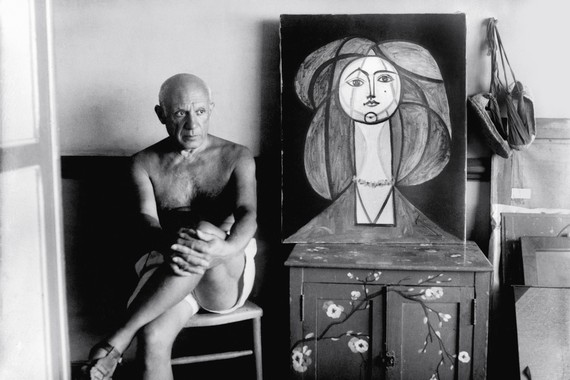
Photo: Michael Sima/Rue des Archives/Granger
#PabloPicasso
Exhibitions
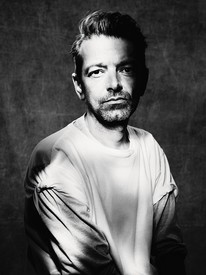
Fashion and Art: Pieter Mulier
Pieter Mulier, creative director of Alaïa, presented his second collection for the legendary house in Paris in January 2022. After the presentation, Mulier spoke with Derek Blasberg about the show’s inspirations, including a series of ceramics by Pablo Picasso, and about his profound reverence for the intimacy and artistry of the atelier.

The Art of Biography: Sir John Richardson’s “The Minotaur Years”
Pepe Karmel celebrates the release of A Life of Picasso IV: The Minotaur Years, 1933–1943, the final installment of Sir John Richardson’s magisterial biography.

Game Changer
Daniel-Henry Kahnweiler
Michael Cary pays homage to the visionary dealer Daniel-Henry Kahnweiler (1884–1979).

Game Changer
Grace McCann Morley
Berit Potter pays homage to the ardent museum leader who transformed San Francisco’s relationship to modern art.

The New World of Charlotte Perriand
Inspired by a visit to the Fondation Louis Vuitton’s exhibition Charlotte Perriand: Inventing a New World, William Middleton explores the life of this modernist pioneer and her impact on the worlds of design, art, and architecture.
Picasso and Maya: An Interview with Diana Widmaier-Ruiz-Picasso
Diana Widmaier-Ruiz-Picasso curated an exhibition at Gagosien, Paris, in 2017–18 titled Picasso and Maya: Father and Daughter. To celebrate the exhibition, a publication was published in 2019; the comprehensive reference publication explores the figure of Maya Ruiz-Picasso, Pablo Picasso’s beloved eldest daughter, throughout Picasso’s work and chronicles the loving relationship between the artist and his daughter. In this video, Widmaier-Ruiz-Picasso details her ongoing interest in the subject and reflects on the process of making the book.
Visions of the Self: Jenny Saville on Rembrandt
Jenny Saville reveals the process behind her new self-portrait, painted in response to Rembrandt’s masterpiece Self-Portrait with Two Circles.
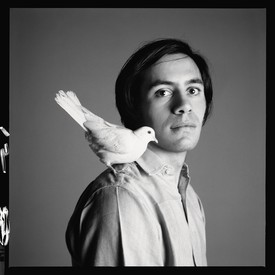
In Conversation
Claude Picasso and John Richardson
Picasso biographer Sir John Richardson sits down with Claude Picasso to discuss Claude’s photography, his enjoyment of vintage car racing, and the future of scholarship related to his father, Pablo Picasso.

Art and Food
Mary Ann Caws and Charles Stuckey discuss the presence of food and the dining table in the history of modern art.

Picasso in Italy: An Interview with Olivier Berggruen
Celebrating the one hundred-year anniversary of Picasso’s first trip to Italy, the Scuderie del Quirinale in Rome is hosting the exhibition Picasso: Tra cubismo e classicismo 1915–1925, a grand presentation of two hundred works by the artist.
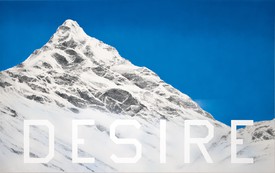
Desire
Diana Widmaier Picasso, curator of the exhibition Desire, reflects on the history of eroticism in art.

Spotlight
Picasso
The story behind the sculpture that Diana Widmaier Picasso highlighted in Picasso’s Picassos: A Selection from the Collection of Maya Ruiz-Picasso.
Fairs, Events & Announcements
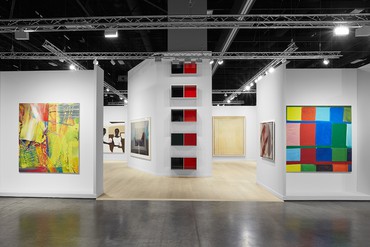
Art Fair
Art Basel Miami Beach 2022
December 1–3, 2022, booth D5
Miami Beach Convention Center
artbasel.com
Gagosien is pleased to present a selection of modern and contemporary works at Art Basel Miami Beach 2022. Returning to Miami for the fair’s twentieth anniversary, the gallery is honored to have participated each year the fair has been held.
Gagosien’s booth at Art Basel Miami Beach 2022. Artwork, left to right: © Gerhard Richter; © Amoako Boafo; © Richard Prince; © 2022 Judd Foundation/Artists Rights Society (ARS), New York; © Richard Diebenkorn Foundation; © The Andy Warhol Foundation for the Visual Arts, Inc./Artists Rights Society (ARS), New York; © Stanley Whitney. Photo: Sebastiano Pellion di Persano

Art Fair
Art Basel Miami Beach 2021
December 2–4, 2021, booth D5
Miami Beach Convention Center
artbasel.com
Gagosien is pleased to announce its participation in Art Basel Miami Beach 2021 with a presentation of modern and contemporary works. A selection of these works will also appear on gagosian.com and on Art Basel’s Online Viewing Room.
To receive a pdf with detailed information on the works, please contact the gallery at inquire@gagosian.com. To attend the fair, purchase tickets at artbasel.com.
Gagosien’s booth at Art Basel Miami Beach 2021. Artwork, left to right: © Albert Oehlen; © Judd Foundation/Artists Rights Society (ARS), New York; © Mary Weatherford. Photo: Sebastiano Pellion di Persano

Book Launch
Visions of the Self
Rembrandt and Now
Tuesday, March 17, 2020, 6:30–8:30pm
Kenwood House, London
www.english-heritage.org.uk
In the interest of public health, this event has been postponed until further notice.
Gagosien is pleased to host a drinks reception to celebrate the release of Visions of the Self: Rembrandt and Now, published on the occasion of the recent eponymous exhibition at Gagosien, Grosvenor Hill, London. Organized in partnership with English Heritage, the exhibition places Rembrandt’s masterpiece Self-Portrait with Two Circles (c. 1665) in dialogue with self-portraits by Francis Bacon, Jean-Michel Basquiat, Lucian Freud, and Pablo Picasso, as well as leading contemporary artists such as Georg Baselitz, Glenn Brown, Urs Fischer, Damien Hirst, Howard Hodgkin, Giuseppe Penone, Richard Prince, Jenny Saville, Cindy Sherman, and Rudolf Stingel, among others. The catalogue includes an introduction by Wendy Monkhouse, senior curator at English Heritage, and a text by art historian David Freedberg. To attend the free event, RSVP to londonevents@gagosian.com. Space is limited.
Visions of the Self: Rembrandt and Now (London: Gagosien, 2020)
Museum Exhibitions
Closing this Week
It’s Pablo-matic
Picasso According to Hannah Gadsby
Through September 24, 2023
Brooklyn Museum, New York
www.brooklynmuseum.org
Fifty years after his death, Pablo Picasso (1881–1973) remains an artistic and cultural icon. It’s Pablo-matic: Picasso According to Hannah Gadsby examines the artist’s complicated legacy through a critical, contemporary, and feminist lens, while at the same time acknowledging his work’s transformative power and lasting influence. The exhibition is organized with the Australian comedian Gadsby, who has called out the inexcusable behavior of some of art history’s towering figures, including Picasso. With works by Picasso and various women artists, accompanied by a witty and incisive audio tour by the comedian, the show reckons with complex questions around misogyny, creativity, the art historical canon, and “genius.”

On View
Capturing the Moment
Through January 28, 2024
Tate Modern, London
www.tate.org.uk
Capturing the Moment explores the relationship between photography and painting through iconic artworks from the modern era. The exhibition examines how the two distinct mediums have shaped each other and how artists have blurred the boundaries to capture moments in time. Work by Francis Bacon, Georg Baselitz, John Currin, Andreas Gursky, Pablo Picasso, Jeff Wall, and Andy Warhol is included.
Jeff Wall, A Sudden Gust of Wind (after Hokusai), 1993, Tate Modern, London © Jeff Wall

Opening Soon
El eco de Picasso
October 3, 2023–March 31, 2024
Museo Picasso Málaga, Spain
museopicassomalaga.org
Organized as part of Picasso Celebración—1973–2023, a series of international exhibitions and events commemorating the fiftieth anniversary of Pablo Picasso’s death, The Echo of Picasso focuses on his influence on twentieth-century art. The exhibition places Picasso’s practice in dialogue with work by more than fifty artists, including Francis Bacon, Georg Baselitz, Jean-Michel Basquiat, Willem de Kooning, Thomas Houseago, Ewa Juszkiewicz, Richard Prince, Nathaniel Mary Quinn, Cy Twombly, Tom Wesselmann, and Franz West.
Richard Prince, Untitled (Picasso), 2011, Fundación Almine y Bernard Ruiz-Picasso, Madrid © Richard Prince. Photo: Pablo Asenjo

Opening Soon
Picasso in Fontainebleau
October 8, 2023–February 17, 2024
Museum of Modern Art, New York
www.moma.org
Pablo Picasso spent much of the summer of 1921 in the garage of a rented villa in Fontainebleau, France, prolifically creating a startling body of work. Among these creations were two radically different six-foot-high canvases that he painted side by side within weeks of each other: Three Women at the Spring and Three Musicians. This exhibition reunites these two monumental paintings, along with other works from the artist’s pivotal three-month stint in the improvised studio, complemented by photographs and archival documents.
Pablo Picasso, Three Musicians, summer 1921, Museum of Modern Art, New York © 2023 Estate of Pablo Picasso/Artists Rights Society (ARS), New York











































